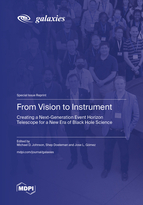From Vision to Instrument: Creating a Next-Generation Event Horizon Telescope for a New Era of Black Hole Science
A special issue of Galaxies (ISSN 2075-4434).
Deadline for manuscript submissions: closed (15 November 2022) | Viewed by 55018
Special Issue Editors
Interests: black holes; VLBI; EHT; ngEHT
Interests: black holes; VLBI; instrumentation
Interests: black holes; active galactic nuclei; relativistic jets; blazars; RMHD simulations
Special Issues, Collections and Topics in MDPI journals
Special Issue Information
Dear Colleagues,
In April 2019, the Event Horizon Telescope Collaboration successfully imaged the first supermassive black hole (M87*), opening a new era in detailed study of these exotic objects. By sharply enhancing the capabilities of black hole imaging, the next-generation EHT (ngEHT) is poised to again revolutionize our view of horizon-scale physics. The ngEHT will enable the first movies of black hole accretion, produce high-dynamic-range images that connect black holes directly to their galactic-scale relativistic jets, and bring into range a larger population of black holes and explosive transients to explore.
This Special Issue will be the first series of papers developing the key science drivers and architecture of the ngEHT. Contributions will sharpen the ngEHT scientific vision and implementation by illuminating and proposing new possibilities in the following areas:
- Fundamental physics (BH properties, tests of GR, EM/GW studies, dark matter, exotic compact objects).
- Black holes and their cosmic context (SMBH formation and evolution, studies of SMBH binaries, multi-wavelength studies of black holes and jets, large-scale jet collimation and kinematics).
- Accretion (probing accretion flow dynamics and structure, turbulence, plasma studies near a BH).
- Jet launching (energy extraction from spinning BHs, black hole magnetospheres, jet kinematics and monitoring).
- Transients and impulsive phenomena (incoherent transients including XRBs, TDEs, and SNe, GW precursor/afterglow studies).
- New horizons (terrestrial applications such as geodesy, coherent sources such as magnetars, masers, FRBs, unexpected ngEHT applications, synergies with other next-generation facilities).
- Algorithms and inference (imaging methods, model fitting to interferometric data, feature extraction, machine learning, parameter estimation, synthetic data, data challenges).
- History, philosophy and cultural implications of building new instruments in the current era.
- Advances in submillimeter VLBI instrumentation (antenna design, receivers, digital backends, data transport and correlation).
- VLBI array design and optimization.
References:
https://ui.adsabs.harvard.edu/abs/2019BAAS...51g.256D/abstract
https://ui.adsabs.harvard.edu/abs/2021ApJS..253....5R/abstract
Dr. Michael D. Johnson
Dr. Shep Doeleman
Dr. Jose L. Gómez
Guest Editors
Manuscript Submission Information
Manuscripts should be submitted online at www.mdpi.com by registering and logging in to this website. Once you are registered, click here to go to the submission form. Manuscripts can be submitted until the deadline. All submissions that pass pre-check are peer-reviewed. Accepted papers will be published continuously in the journal (as soon as accepted) and will be listed together on the special issue website. Research articles, review articles as well as short communications are invited. For planned papers, a title and short abstract (about 100 words) can be sent to the Editorial Office for announcement on this website.
Submitted manuscripts should not have been published previously, nor be under consideration for publication elsewhere (except conference proceedings papers). All manuscripts are thoroughly refereed through a single-blind peer-review process. A guide for authors and other relevant information for submission of manuscripts is available on the Instructions for Authors page. Galaxies is an international peer-reviewed open access semimonthly journal published by MDPI.
Please visit the Instructions for Authors page before submitting a manuscript. The Article Processing Charge (APC) for publication in this special issue is 0 CHF (Swiss Francs). Submitted papers should be well formatted and use good English. Authors may use MDPI's English editing service prior to publication or during author revisions.
Keywords
- black holes
- general relativity
- interferometry
- radio instrumentation
- accretion
- relativistic jets
- cosmology
- very-long-baseline interferometry







